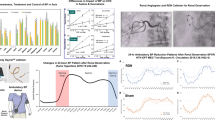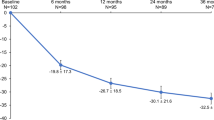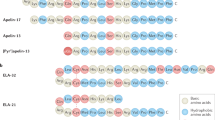Abstract
Renal denervation (RDN) has been shown in several studies to reduce blood pressure (BP) in patients with resistant hypertension (RH). Data on potential biomarkers associated with BP changes remain scarce. We evaluated whether soluble vascular endothelial growth factor receptor (sVEGFR-1) is affected by the procedure. A total of 57 patients with RH participated in this study. BP and heart rate were recorded at baseline and at 3 months follow-up, at which time blood samples were collected to determine the levels of sVEGFR-1, VEGF-A, VEGF-C, nitric oxide (NO), soluble vascular adhesion molecule 1 and soluble intracellular adhesion molecule 1. None of the biomarkers had a predictive value that could identify responders vs non-responders to RDN. However, sVEGFR-1 concentration was dramatically reduced after RDN (5913±385 vs 280±57 pg ml−1, P<0.001). At the same time VEGF-A levels were significantly increased (10.0±3.0 vs 55.5±7.9 pg ml−1, P<0.001), without significant changes in VEGF-C. NO levels were significantly increased after RDN in the whole group (82.6±6.2 vs 106.9±7.8 μM, P=0.021). Interestingly, the elevation in NO levels at 3 months was only seen in patients who demonstrated a reduction in systolic BP of ⩾10 mm Hg (78.9±8.3 vs 111.6±11.7 μM, P=0.018). We report a significant reduction in sVEGFR-1 levels after RDN procedure, which was accompanied by a significant increase in VEGF-A concentration as well as NO. Changes in plasma cytokines were not quantitatively linked to magnitude of BP reduction. An RDN-induced reduction in sVEGFR-1 plasma levels and increase in VEGF-A would raise the VEGF-A/sVEGFR-1 ratio, thereby increasing VEGF-A bioavailability to act on its full-length receptor and may contribute to the BP-lowering effect potentially via NO-mediated pathways.
This is a preview of subscription content, access via your institution
Access options
Subscribe to this journal
Receive 12 digital issues and online access to articles
$119.00 per year
only $9.92 per issue
Buy this article
- Purchase on Springer Link
- Instant access to full article PDF
Prices may be subject to local taxes which are calculated during checkout


Similar content being viewed by others
References
Mancia G, Fagard R, Narkiewicz K, Redon J, Zanchetti A, Bohm M et al. ESH/ESC guidelines for the management of arterial hypertension: the Task Force for the Management of Arterial Hypertension of the European Society of Hypertension (ESH) and of the European Society of Cardiology (ESC). Eur Heart J 2013; 34 (28): 2159–2219.
Esler M, Kaye D . Sympathetic nervous system activation in essential hypertension, cardiac failure and psychosomatic heart disease. J Cardiovasc Pharmacol 2000; 35 (7 Suppl 4): S1–S7.
Symplicity HTNI Symplicity HTNI, Esler MD Symplicity HTNI, Krum H Symplicity HTNI, Sobotka PA Symplicity HTNI, Schlaich MP Symplicity HTNI, Schmieder RE et al. Renal sympathetic denervation in patients with treatment-resistant hypertension (The Symplicity HTN-2 Trial): a randomised controlled trial. Lancet 2010; 376 (9756): 1903–1909.
Bhatt DL, Kandzari DE, O'Neill WW, D'Agostino R, Flack JM, Katzen BT et al. A controlled trial of renal denervation for resistant hypertension. N Engl J Med 2014; 370 (15): 1393–1401.
Krum H, Schlaich M, Whitbourn R, Sobotka PA, Sadowski J, Bartus K et al. Catheter-based renal sympathetic denervation for resistant hypertension: a multicentre safety and proof-of-principle cohort study. Lancet 2009; 373 (9671): 1275–1281.
Krum H, Schlaich MP, Sobotka PA, Bohm M, Mahfoud F, Rocha-Singh K et al. Percutaneous renal denervation in patients with treatment-resistant hypertension: final 3-year report of the Symplicity HTN-1 study. Lancet 2014; 383 (9917): 622–629.
Hering D, Lambert EA, Marusic P, Walton AS, Krum H, Lambert GW et al. Substantial reduction in single sympathetic nerve firing after renal denervation in patients with resistant hypertension. Hypertension 2013; 61 (2): 457–464.
Hering D, Marusic P, Walton AS, Lambert EA, Krum H, Narkiewicz K et al. Sustained sympathetic and blood pressure reduction 1 year after renal denervation in patients with resistant hypertension. Hypertension 2014; 64 (1): 118–124.
Azizi M, Sapoval M, Gosse P, Monge M, Bobrie G, Delsart P et al. Optimum and stepped care standardised antihypertensive treatment with or without renal denervation for resistant hypertension (DENERHTN): a multicentre, open-label, randomised controlled trial. Lancet 2015; 385 (9981): 1957–1965.
Esler MD, Krum H, Schlaich M, Schmieder RE, Bohm M, Sobotka PA et al. Renal sympathetic denervation for treatment of drug-resistant hypertension: one-year results from the Symplicity HTN-2 randomized, controlled trial. Circulation 2012; 126 (25): 2976–2982.
Dörr O, Liebetrau C, Mollmann H, Gaede L, Troidl C, Rixe J et al. Soluble fms-like tyrosine kinase-1 and endothelial adhesion molecules (intercellular cell adhesion molecule-1 and vascular cell adhesion molecule-1) as predictive markers for blood pressure reduction after renal sympathetic denervation. Hypertension 2014; 63 (5): 984–990.
Bouloumie A, Schini-Kerth VB, Busse R . Vascular endothelial growth factor up-regulates nitric oxide synthase expression in endothelial cells. Cardiovasc Res 1999; 41 (3): 773–780.
Eikelis N, Hering D, Marusic P, Sari C, Walton A, Phillips S et al. The effect of renal denervation on endothelial function and inflammatory markers in patients with resistant hypertension. Int J Cardiol 2015; 188: 96–98.
Mancia G, De Backer G, Dominiczak A, Cifkova R, Fagard R, Germano G et al. 2007 Guidelines for the Management of Arterial Hypertension: The Task Force for the Management of Arterial Hypertension of the European Society of Hypertension (ESH) and of the European Society of Cardiology (ESC). J Hypertens 2007; 25 (6): 1105–1187.
Calhoun DA, Jones D, Textor S, Goff DC, Murphy TP, Toto RD et al. Resistant hypertension: diagnosis, evaluation, and treatment. A scientific statement from the American Heart Association Professional Education Committee of the Council for High Blood Pressure Research. Hypertension 2008; 51 (6): 1403–1419.
Schlaich MP, Sobotka PA, Krum H, Lambert E, Esler MD . Renal sympathetic-nerve ablation for uncontrolled hypertension. N Engl J Med 2009; 361 (9): 932–934.
Tsikas D . Analysis of nitrite and nitrate in biological fluids by assays based on the Griess reaction: appraisal of the Griess reaction in the L-arginine/nitric oxide area of research. J Chromatogr B Analyt Technol Biomed Life Sci 2007; 851 (1-2): 51–70.
Leung DW, Cachianes G, Kuang WJ, Goeddel DV, Ferrara N . Vascular endothelial growth factor is a secreted angiogenic mitogen. Science 1989; 246 (4935): 1306–1309.
Gerber HP, McMurtrey A, Kowalski J, Yan M, Keyt BA, Dixit V et al. Vascular endothelial growth factor regulates endothelial cell survival through the phosphatidylinositol 3'-kinase/Akt signal transduction pathway. Requirement for Flk-1/KDR activation. J Biol Chem 1998; 273 (46): 30336–30343.
Amraoui F, Spijkers L, Hassani Lahsinoui H, Vogt L, van der Post J, Peters S et al. SFlt-1 elevates blood pressure by augmenting endothelin-1-mediated vasoconstriction in mice. PLoS ONE 2014; 9 (3): e91897.
Hertig A, Berkane N, Lefevre G, Toumi K, Marti HP, Capeau J et al. Maternal serum sFlt1 concentration is an early and reliable predictive marker of preeclampsia. Clin Chem 2004; 50 (9): 1702–1703.
Di Marco GS, Kentrup D, Reuter S, Mayer AB, Golle L, Tiemann K et al. Soluble Flt-1 links microvascular disease with heart failure in CKD. Basic Res Cardiol 2015; 110 (3): 30.
Belgore FM, Blann AD, Li-Saw-Hee FL, Beevers DG, Lip GY . Plasma levels of vascular endothelial growth factor and its soluble receptor (SFlt-1) in essential hypertension. Am J Cardiol 2001; 87 (6): 805–807 A9.
Hagmann H, Bossung V, Belaidi AA, Fridman A, Karumanchi SA, Thadhani R et al. Low-molecular weight heparin increases circulating sFlt-1 levels and enhances urinary elimination. PLoS ONE 2014; 9 (1): e85258.
Rosenberg VA, Buhimschi IA, Lockwood CJ, Paidas MJ, Dulay AT, Ramma W et al. Heparin elevates circulating soluble fms-like tyrosine kinase-1 immunoreactivity in pregnant women receiving anticoagulation therapy. Circulation 2011; 124 (23): 2543–2553.
Facemire CS, Nixon AB, Griffiths R, Hurwitz H, Coffman TM . Vascular endothelial growth factor receptor 2 controls blood pressure by regulating nitric oxide synthase expression. Hypertension 2009; 54 (3): 652–658.
Li Z, Zhang Y, Ying Ma J, Kapoun AM, Shao Q, Kerr I et al. Recombinant vascular endothelial growth factor 121 attenuates hypertension and improves kidney damage in a rat model of preeclampsia. Hypertension 2007; 50 (4): 686–692.
Ahmad S, Hewett PW, Al-Ani B, Sissaoui S, Fujisawa T, Cudmore MJ et al. Autocrine activity of soluble Flt-1 controls endothelial cell function and angiogenesis. Vasc Cell 2011; 3 (1): 15.
Tsurumi Y, Murohara T, Krasinski K, Chen D, Witzenbichler B, Kearney M et al. Reciprocal relation between VEGF and NO in the regulation of endothelial integrity. Nat Med 1997; 3 (8): 879–886.
Ku DD, Zaleski JK, Liu S, Brock TA . Vascular endothelial growth factor induces EDRF-dependent relaxation in coronary arteries. Am J Physiol 1993; 265 (2 Pt 2): H586–H592.
Morales-Ruiz M, Fulton D, Sowa G, Languino LR, Fujio Y, Walsh K et al. Vascular endothelial growth factor-stimulated actin reorganization and migration of endothelial cells is regulated via the serine/threonine kinase Akt. Circ Res 2000; 86 (8): 892–896.
Acknowledgements
We thank the study participants for their time, cooperation and effort. The research described in this paper has been partly supported by the National Health and Medical Research Council of Australia and the Victorian Government’s Operational Infrastructure Support Program.
Author information
Authors and Affiliations
Corresponding author
Ethics declarations
Competing interests
Drs ASW, HK, GWL, MDE and MPS are investigators in studies sponsored by Medtronic. The laboratories of Drs MPS, GWL and MDE currently received research funding from Medtronic. Professor GWL has acted as a consultant for Medtronic and has received honoraria or travel support for presentations from Pfizer, Wyeth Pharmaceuticals, Servier and Medtronic. Professor MDE serves on scientific advisory boards of Abbott (formerly Solvay) Pharmaceuticals and Medtronic. Professor MPS serves on scientific advisory boards for Abbott (formerly Solvay) Pharmaceuticals, BI, Novartis Pharmaceuticals and Medtronic and has received honoraria and travel support from Abbott, BI, Servier, Novartis and Medtronic. The remaining author declares no conflict of interest.
Rights and permissions
About this article
Cite this article
Eikelis, N., Hering, D., Marusic, P. et al. Soluble vascular endothelial growth factor receptor-1 is reduced in patients with resistant hypertension after renal denervation. J Hum Hypertens 31, 248–252 (2017). https://doi.org/10.1038/jhh.2016.64
Received:
Revised:
Accepted:
Published:
Issue Date:
DOI: https://doi.org/10.1038/jhh.2016.64



